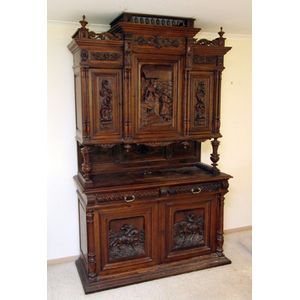French Oak Louis XIII Sideboard with Figural Carvings
You must be a subscriber, and be logged in to view price and dealer details.
Subscribe Now to view actual auction price for this item
When you subscribe, you have the option of setting the currency in which to display prices to $Au, $US, $NZ or Stg.
- Oak - Native to Europe and England, oak has been used for joinery, furniture and building since the beginning of the medieval civilisation. It is a pale yellow in colour when freshly cut and darkens with age to a mid brown colour.
Oak as a furniture timber was superceded by walnut in the 17th century, and in the 18th century by mahogany,
Semi-fossilised bog oak is black in colour, and is found in peat bogs where the trees have fallen and been preserved from decay by the bog. It is used for jewellery and small carved trinkets.
Pollard oak is taken from an oak that has been regularly pollarded, that is the upper branches have been removed at the top of the trunk, result that new branches would appear, and over time the top would become ball-like. . When harvested and sawn, the timber displays a continuous surface of knotty circles. The timber was scarce and expensive and was used in more expensive pieces of furniture in the Regency and Victorian periods. - Hardware - A general term applied to the metal fittings on an item of furniture, such as locks, hinges and handles. Whilst most furniture will usually have brass hardware as it does not rust, some earlier rustic objects such as coffers sometimes have iron hardware.
- Trestle Table - The medieval table was usually a loose board, placed on removeable folding supports called trestles. In the 16th century, trestles fixed to the top of the table were introduced at each end of the frame, each resting on a broad base or foot, often connected and supported by one or two stretchers.
- Pediment - The uppermost section of a tall usually double-heightened piece of cabinet furniture, surmounting the cornice. The pediment can take a variety of forms derived from the architecture of classical antiquity. A broken pediment is of triangular shape, however, the two raised sides do not meet at the apex but are 'broken' the gap between them often ornamented with an urn or finial. Swan-neck pediments are of similar form, although the uprights are gracefully arched, resembling a swan's neck. They are often found, for example, on longcase clocks.
- Foliate - Decorated with leaves or leaf-like forms.
This item has been included into following indexes:
Visually similar items

An Impressive antique French walnut Henry II style hunting buffet, carved in high relief with a central hunting scene, and various other designs, of breakfront shape, approx. cm high, cm wide, deep.

Baronial hall seat, Highback oak with foliate, and medallion carvings

Antique French Henri II Gothic carved walnut two height buffet, approx 225 cm high, 146 cm wide

An antique French oak credence in the Gothic manner, later 19th century, an architectural cornice above a cupboard with arrow point hinges and a steel lock flanked by panels relief carved with knight and monk style figures within arched Gothic niches, an o
